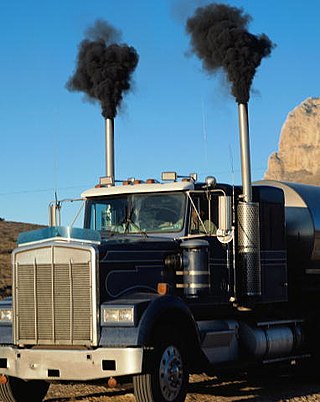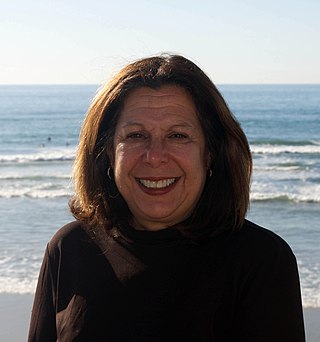The following outline is provided as an overview of and topical guide to chemistry:
Environmental engineering is a professional engineering discipline related to environmental science. It encompasses broad scientific topics like chemistry, biology, ecology, geology, hydraulics, hydrology, microbiology, and mathematics to create solutions that will protect and also improve the health of living organisms and improve the quality of the environment. Environmental engineering is a sub-discipline of civil engineering and chemical engineering. While on the part of civil engineering, the Environmental Engineering is focused mainly on Sanitary Engineering.

Soot is a mass of impure carbon particles resulting from the incomplete combustion of hydrocarbons. It is more properly restricted to the product of the gas-phase combustion process but is commonly extended to include the residual pyrolysed fuel particles such as coal, cenospheres, charred wood, and petroleum coke that may become airborne during pyrolysis and that are more properly identified as cokes or char.

Atmospheric chemistry is a branch of atmospheric science in which the chemistry of the Earth's atmosphere and that of other planets is studied. It is a multidisciplinary approach of research and draws on environmental chemistry, physics, meteorology, computer modeling, oceanography, geology and volcanology and other disciplines. Research is increasingly connected with other areas of study such as climatology.

The Max Planck Institute for Chemistry is a non-university research institute under the auspices of the Max Planck Society in Mainz, Germany. It was created as the Kaiser Wilhelm Institute for Chemistry in 1911 in Berlin.

Environmental engineering science (EES) is a multidisciplinary field of engineering science that combines the biological, chemical and physical sciences with the field of engineering. This major traditionally requires the student to take basic engineering classes in fields such as thermodynamics, advanced math, computer modeling and simulation and technical classes in subjects such as statics, mechanics, hydrology, and fluid dynamics. As the student progresses, the upper division elective classes define a specific field of study for the student with a choice in a range of science, technology and engineering related classes.
John Hersh Seinfeld is an American chemical engineer and pioneering expert in atmospheric science. His research on air pollution has influenced public policy, and he developed the first mathematical model of air quality, which has influenced air pollution tracking and research across the United States. He has spent his career at the California Institute of Technology, where he is currently the Louis E. Nohl Professor of Chemical Engineering.

Linda Marie Abriola is an American environmental and civil engineer who specializes in the study of organic chemical liquid contaminants in porous media. She is currently the Joan Wernig and E. Paul Sorensen Professor of Engineering at the Brown University School of Engineering.

Bruce E. Rittmann is Regents' Professor of Environmental Engineering and Director of the Swette Center for Environmental Biotechnology at the Biodesign Institute of Arizona State University. He was also elected a member of the National Academy of Engineering in 2004 for pioneering the development of biofilm fundamentals and contributing to their widespread use in the cleanup of contaminated waters, soils, and ecosystems.
Barbara J. Finlayson-Pitts is a Canadian-American atmospheric chemist. She is a professor in the chemistry department at the University of California, Irvine and is the Director of AirUCI Institute. Finlayson-Pitts and James N. Pitts, Jr. are the authors of Chemistry of the Upper and Lower Atmosphere: Theory, Experiments, and Applications (1999). She has been a member of the National Academy of Sciences since 2006 and is the laureate for the 2017 Garvan–Olin Medal. In 2016 she co-chaired the National Academy of Science report "The Future of Atmospheric Chemistry Research"

Vicki H. Grassian is a distinguished professor in the department of chemistry and biochemistry at the University of California, San Diego. She also holds the distinguished chair in physical chemistry.
Noelle Eckley Selin is an atmospheric chemist and Associate Professor at Massachusetts Institute of Technology in the Institute for Data, Systems and Society and the Department of Earth, Atmospheric and Planetary Sciences.
Hind Al-Abadleh is a professor of chemistry at Wilfrid Laurier University in Waterloo, Ontario, Canada. She studies the physical chemistry of environmental interfaces, aerosols and climate change.
Kimberly A. Prather is an American atmospheric chemist. She is a distinguished chair in atmospheric chemistry and a distinguished professor at the Scripps Institution of Oceanography and department of chemistry and biochemistry at UC San Diego. Her work focuses on how humans are influencing the atmosphere and climate. In 2019, she was elected a member of the National Academy of Engineering for technologies that transformed understanding of aerosols and their impacts on air quality, climate, and human health. In 2020, she was elected as a member of the National Academy of Sciences. She is also an elected Fellow of the American Philosophical Society, American Geophysical Union, the American Association for the Advancement of Science, American Philosophical Society, and the American Academy of Arts and Sciences.
Sonia Maria Kreidenweis is an American Professor of Atmospheric Sciences at Colorado State University. Her research considers aerosols and their impact on weather and the climate. She has previously served as President of the American Association for Aerosol Research and was a board member of the American Meteorological Society. She was elected a Fellow of the American Geophysical Union in 2019.
Jennifer G. Murphy is a Canadian environmental chemist and an associate professor at the University of Toronto. She is known for her research how air pollutants such as increased reactive nitrogen affect the global climate.

Julia Yvonne Schmale is a German environmental scientist. She is a specialist in the micro-physical makeup of the atmosphere, in particular aerosols and their interaction with clouds. She is a professor at EPFL and the head of the Extreme Environments Research Laboratory (EERL). She is a participant in the Multidisciplinary drifting Observatory for the Study of Arctic Climate (MOSAiC) expeditions.
Barbara Jo Turpin is an American chemist who is a Professor of Atmospheric Chemistry at the University of North Carolina at Chapel Hill. Her research considers aerosol science and environmental engineering. Turpin studies the formation of organic particulate matter via aqueous chemistry. She was awarded the 2018 American Chemical Society Award for Creative Advances in Environmental Science and Technology. Turpin is a Fellow of the American Association for Aerosol Research, American Geophysical Union and American Association for the Advancement of Science.
Vivian Faye McNeill is an American atmospheric chemist who is professor of chemical engineering at Columbia University. She leads the University's initiative Clean Air Toolbox for Cities. McNeill provided expert guidance on aerosols and ventilation throughout the COVID-19 pandemic.
Ann Marie Grover Carlton is an American academic working as a professor of chemistry at the University of California, Irvine, with expertise in atmospheric chemistry. She is a reviewing editor for the journal Science, and the winner of multiple awards and fellowships, notably the quadrennial Roger Revelle Fellowship for Global Stewardship from the American Association for the Advancement of Science. In this fellowship, she advised the Biden administration on climate and the environment in the Office of Science and Technology Policy, beginning in September 2021. Early in the COVID-19 pandemic, she was a proponent of the theory of airborne transmission of the virus, consequently appearing as an expert guest on NPR. She is the scientific leader on the Southern Oxidant & Aerosol Study (SOAS), the largest U.S. atmospheric chemistry field project in decades, for which the short documentary Skycatcher was made.







